Review of Furor cucumbers: advantages and disadvantages, crop characteristics and growing tips
Up to 20 kg of cucumbers per square meter, earlier fruiting and long shelf life of the fruit - these are the qualities the Furor hybrid has. The harvest from even a small plot is enough for the whole family. Read the article about what other advantages this hybrid has and how to grow it.
Description of cucumbers
Furor is grown both in open and closed ground. However, in a greenhouse with proper care, the plant gives a greater yield: from 1 sq. m from 20 kg of cucumbers.
The length of the plant reaches 3 m. The leaves are small, the petioles are long. The leaf has the shape of an angular heart with a slightly corrugated surface.
Reference! Cucumbers bloom in bouquets, which allows you to harvest a high harvest from a small area. One plant node can have up to four flowers.
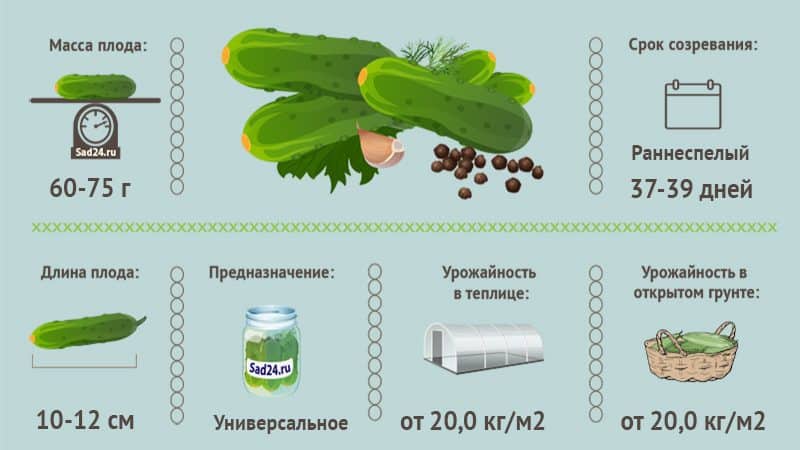
Distinctive features
The hybrid bears fruits that are even, not very large, and approximately the same size. They have small tubercles, as well as whitish fluff.
The distinctive features of cucumber include:
- fruit shape in the form of a cylinder;
- diameter about 3 cm;
- length up to 12 cm;
- fetal weight 60-80 g;
- green uniform color without stripes.
Composition, properties, benefits, calorie content
This vegetable is valued because it contains a lot of water (up to 95%) and substances beneficial to the body:
- vitamins A, C, PP, group B;
- zinc;
- manganese;
- sodium;
- copper;
- beta-carotene;
- potassium;
- folic acid;
- iron;
- chromium;
- magnesium;
- iodine;
- phosphorus.
Cucumbers have the property of flushing the kidneys, removing toxins and heavy metal salts. This vegetable is rich in fiber, which allows you to gently cleanse the intestines, stimulating its work. Positive properties also include:
- the ability to prevent the appearance of cholesterol plaques;
- positive effect on the thyroid gland;
- prevention of a spectrum of cardiovascular diseases.
The calorie content of cucumbers is only 15 kcal per 100 g, which makes it an excellent dietary product.
The pulp is juicy, tender and dense, without voids inside. The aroma is typical cucumber. Furor has a sweet taste without bitterness, which is especially appreciated by lovers of this vegetable.
Reference! Since the hybrid forms ovaries without the participation of male cells, the seeds inside the fruit are almost transparent and underdeveloped. They are almost not noticeable in food.
Characteristics
The plant tolerates weather changes quite steadfastly: warming or, conversely, cooling.
Important! Hybrid Furor is able to withstand even drought for a short time. The ovaries will not fall off.
Furor is perfect for both personal plots and large farms growing crops for sale.
The plant is capable of producing a harvest approximately 40 days after the seeds germinate.
Important! The hybrid bears fruit for a long time – up to three months, so one bush can produce up to 7 kg of cucumbers.
Furor needs:
- regular watering;
- feeding;
- pinching shoots;
- in lighting;
- fertile soil.
Furor F1 is a parthenocarpic plant, that is, the plant does not require pollen to form ovaries. A high yield will be obtained without the participation of pollinating insects.
Another important quality is good transportability. The fruits can be stored for a long time and do not develop any defects.
How to grow your own
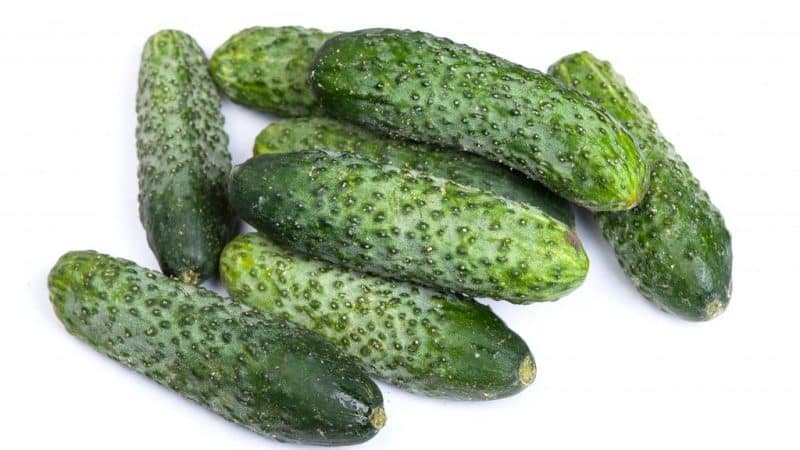
Before planting, it is necessary to correctly select the location of the beds, as well as the time of planting. Seeds are planted in March or April so that the seedlings are ready by May-June.
Important! The minimum required soil temperature for planting vegetables is +15°C.
Furor loves sunny, windless places. The soil is preferably fertile, with a low concentration of nitrogen. The culture grows well in a mixture of turf with peat, humus, and sawdust. Future beds are prepared in the fall by digging up the soil and fertilizing it with compost.
Planting by seeds and seedlings
You can grow cucumbers by planting them in the ground right away or growing seedlings.
The seed method is simple. Rows are made in the garden bed, deepening them by 5 cm. Seeds are placed in them at an equal distance from each other, then watered. The seeds should be covered with straw or paper.
Reference! For better germination, seeds can be germinated by wrapping them in a damp cloth. When the sprouts hatch 0.5 cm, they are ready for sowing.
The seedling method is more labor-intensive, but it allows you to get the harvest a couple of weeks earlier. It has a number of features:
- seeds are sown in peat pots;
- the seedlings are transferred to the ground along with a clod of earth to preserve the roots;
- the pots are placed so that the roots of different seedlings do not intertwine;
- The seedlings are ready when there are five leaves and the height of the bush is at least 25 cm.
Growing in stages and care
Planting is done in the soil, leaving a distance of up to 35 cm between seedlings. To ensure that the seedlings grow strong, follow this algorithm:
- The distance between seedlings is 30-40 cm. Per 1 sq. m no more than three plants are planted.
- Compost is poured into each hole, followed by a layer of soil.
- Each planting site is watered abundantly.
- The seedlings are transferred to the holes along with peat from the pot.
- The roots of the plants are covered with earth and compacted.
- Each seedling is watered using about 3 liters of water.
Further care consists of regular watering and fertilizing, loosening and pinching.
The hybrid is watered every 4-5 days, pouring about 5 liters of water under each bush. When the vegetable blooms, water it more often: every 3-4 days, and if it’s hot outside, then every day. The soil is loosened, and after flowering begins, loosening is stopped.
At the beginning of the summer season, it is recommended to feed the vegetable with mullein infusion prepared in a ratio of 1:10. Each seedling requires about 3 liters of fertilizer. Before the fruits appear, the plant is fed with superphosphates or viburnum salt at the rate of 30 g of the substance per 10 liters of water. The procedure is carried out every 2-3 weeks.
The plant, having reached a height of 2 m, needs pinching. All flowers and shoots are removed, leaving about six lateral shoots on the plant, approximately 30 cm long. They are removed when they reach a length of 40-50 cm.
Features of cultivation and possible difficulties
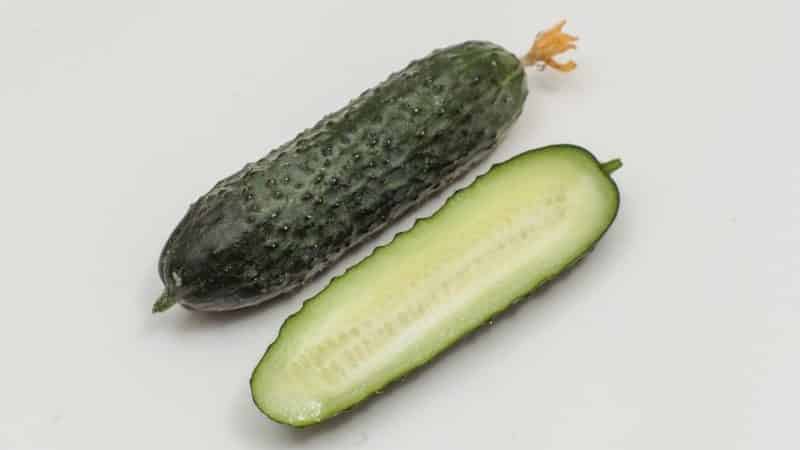
Growing features include:
- Requirement for light.
- Although Furor can tolerate short periods of drought, in general it loves moisture, especially during flowering and fruiting.
- A support is required on which the shoots will rise as they grow. It can be a wooden or wire frame.
- The root system of seedlings is fragile, which is why loosening should only be done between rows.
- It is not advisable to use soil rich in nitrogen for planting.
Diseases and pests
Furor is immune to many diseases characteristic of this vegetable. Among them:
- powdery mildew disease;
- olive spot;
- ordinary mosaic.
For preventive purposes, seedlings are sprayed with a solution of iodine or wood ash.
However, there are pests that can interfere with the growth and development of the plant:
- aphid;
- mole cricket;
- wireworm;
- spider mite;
- thrips;
- root-knot nematode.
To combat them, folk remedies are used:
- ash solutions;
- tobacco dust diluted in water;
- infusion of wormwood.
If traditional methods do not help, use the chemical preparations Iskra, Actellik or Aktara.
Important! Chemical pest control agents are used no later than three weeks before harvest!
To prevent the appearance of root-knot nematodes, the soil is disinfected before planting, and gardening tools are also kept clean. Already contaminated soil should be replaced with new one.
The plant is more likely to get sick if the rules of agricultural technology are not followed. For example, the seedlings are planted too crowded or the greenhouse is not ventilated regularly.
Harvesting and application
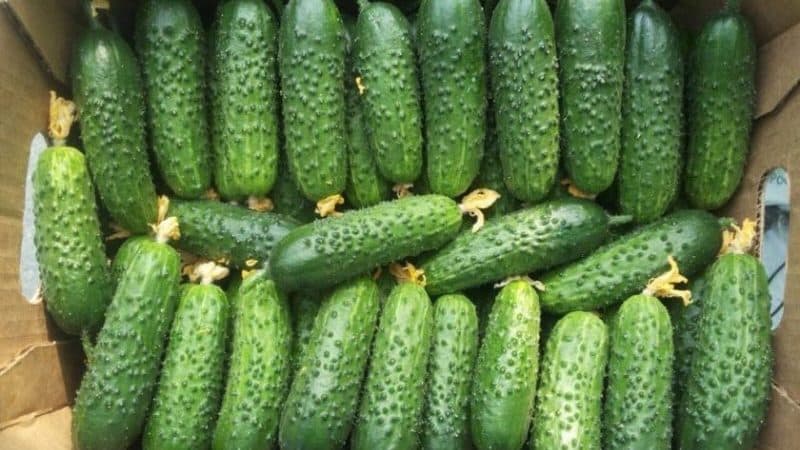
It is best to harvest in the morning or late evening, when the fruits are most elastic.
Reference! It is best to cut cucumbers with a garden tool so as not to injure the plant's vines with your hands.
Freshly picked fruits are immediately placed in a cool place or at least covered with a cloth.
The hybrid begins to bear fruit 40-45 days after the first shoots appear and produces a harvest within two or three months. The fruits are versatile in the kitchen; they can be used fresh and for winter preparations.
Advantages and disadvantages
Hybrid Furor has both its pros and cons. The first include:
- early and long fruiting process;
- fast growth;
- good transport tolerance;
- neat “correct” shape of the fruit;
- resistance to adverse environmental conditions;
- resistance to many diseases;
- excellent keeping quality;
- lack of bitterness in cucumbers;
- fruits do not change color if overripe;
- "pickling" character.
Disadvantages include:
- since this is a hybrid and not a variety, it will not be possible to grow Furor from collected seeds;
- if not properly cared for in open ground, the fruits may have an irregular shape;
- the price of seeds is relatively high compared to varietal cucumbers.
Reviews
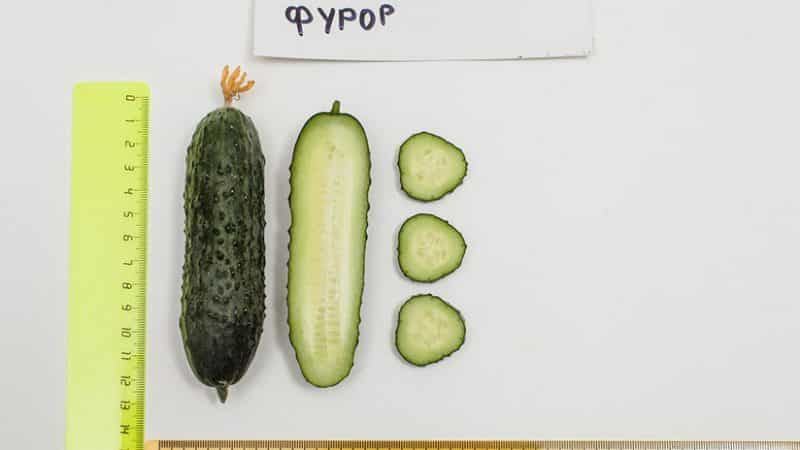
Summer residents generally have a positive attitude towards hybrids, especially such productive ones as Furor.
Anton, Volgograd: “I planted these cucumbers at the dacha, my friends recommended them. I germinated the seeds as I always do: soaked them in lukewarm water and planted them in peat pots. Within a week or a week and a half, shoots appeared, and about a month later I transplanted them into open ground. As a result, the cucumbers grew wonderful: heavy, beautiful color and shape. The pulp inside is very tender, you can hardly feel the seeds.”
Alexander, Stary Oskol: “I grew Furor from purchased seeds, and a little less than a month later I planted it in open ground. The cucumbers have grown beautifully! The fruits themselves are heavy, there are no voids inside. The peel of the cucumbers is thin, very juicy, sweet and you can’t feel the seeds. Suitable for both salad preparation and preparations.”
Maria, Belgorod: “I tried this hybrid last season because... I love everything new. A bag of seeds costs more than usual: 45 rubles. I sprouted the seeds easily and made seedlings in peat pots. As a result, tasty, juicy fruits with thin skin grew. I use it in salads and for canning.”
Conclusion
With proper care, Furor cucumbers produce an excellent harvest while occupying a small area. Regular feeding and watering, as well as careful observations of the growth and development of the plant, will allow you to grow tender and sweet cucumbers that you will certainly like.